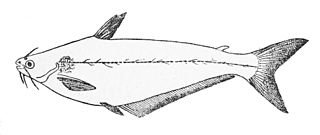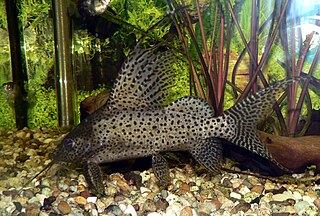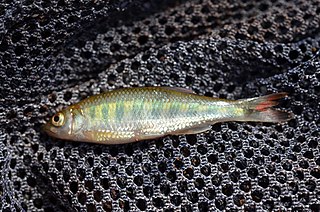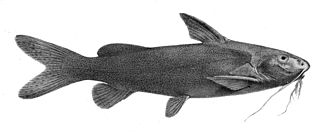 W
WEthiopia's fisheries are entirely freshwater, in its many lakes, rivers, and reservoirs, as it has no marine coastline. Fishing contributed less than 1 percent of the gross domestic product in 1987. A study reported that 15,389 tonnes were caught in 2001, only 30% of an estimated potential of 51,481 tonnes.
 W
WThe African butter catfish is a species of fish in the family Schilbeidae. It is native to many major river systems in Africa. Other common names for the fish include butter fish, butter barbel, African glass catfish, lubangu, mystus catfish, silver barbel, and silver catfish. It was originally described as Silurus mystus by Carl Linnaeus in 1758.
 W
WThe bayad, is a species of bagrid catfish from Africa.
 W
WChiloglanis modjensis is a species of upside-down catfish (Mochokidae) endemic to Ethiopia. This species grows to a length of 4 centimetres (1.6 in) SL.
 W
WChiloglanis niloticus is a species of upside-down catfish native to the Nile River and Niger River. This species grows to a length of 4.5 centimetres (1.8 in) SL.
 W
WThe featherfin squeaker or featherfin synodontis is a species of Synodontis catfish. This species is found in the basins of the White Nile, Volta and Niger Rivers and the Chad Basin. Also known simply as featherfin catfish. Featherfin squeakers are called such due to their ability to make noises to communicate with one another and also for their high feather-like fin which is valued by many hobbyists. Wild specimens can grow to a length of 30.0 centimetres (11.8 in) SL.
 W
WGarra makiensis is a species of ray-finned fish in the genus Garra. It is endemic to Ethiopia.
 W
WLabeo bottegi is fish in genus Labeo. It is known from Ethiopia, Kenya, and Somalia.
 W
WRaiamas senegalensis is a species of cyprinid fish in the genus Raiamas from western Africa east to the River Nile. It sometimes is found in the aquarium trade.
 W
WSynodontis batensoda, the upsidedown catfish, is a species of mochokid upside-down catfish. It is unevenly distributed in inland waters across Africa from Senegal to Ethiopia, and is also known as a squeaker or giant upside-down catfish. It was originally described by Eduard Rüppell in 1832 in the paper "Continuation of the description and figure of several new fish, in the Nile. p1-14".
 W
WSynodontis caudovittatus, known as the white-finned synodontis, is a species of upside-down catfish that is native to the Nile basin of Ethiopia, South Sudan, and Sudan. It was first described by British-Belgian zoologist George Albert Boulenger in 1901, from specimens collected in the White Nile, at the mouth of Lake No in South Sudan. The species name caudovittatus comes from the Latin word cauda, meaning "tail", and the Latin word vitta, meaning "stripe" and refers to the coloration of the tailfin.
 W
WSynodontis clarias, known as the red tailed synodontis, or the mandi, is a species of upside-down catfish that occurs widely in the waters of northern Africa. It was first described by Swedish zoologist Carl Linnaeus in 1758 as Silurus clarias. The original specimens were obtained in Egypt, near Cairo. The meaning of the species name clarias is not certain, but may possibly have been used to mean "bright" or "clear".
 W
WSynodontis filamentosus, known as the longfin synodontis, is a species of upside-down catfish that is native to the basins of the Nile, Volta and Niger Rivers as well as the Chad Basin. It was first described by British-Belgian zoologist George Albert Boulenger in 1901, from specimens obtained near the mouth of Lake No, on the White Nile in Sudan. The species name filamentosus comes from the elongated rays of the dorsal and caudal fins.
 W
WSynodontis frontosus, known as the Sudan squeaker, is a species of upside-down catfish that is widely distributed throughout northern and central Africa. It has been reported in Chad, Democratic Republic of the Congo, Ethiopia, Kenya, Somalia, Sudan, and Uganda. It was first described by French zoologist Léon Vaillant in 1895, from specimens collected in the White Nile in Sudan. The species name frontosus is Latin, and means "broad head".
 W
WSynodontis geledensis, known as the Geledi squeaker, is a species of upside-down catfish that is native to Ethiopia, Kenya and Somalia where it can be found in the Lorian Swamp, the Shebelle and Ewaso Ng'iro rivers. It was first described by German zoologist Albert Günther in 1896, from specimens obtained near Geledi, on the Shebeli River in east Africa. The species name geledensis comes from Geledi, Somalia, the location where the first specimens were first found.
 W
WSynodontis membranaceus, known as the moustache catfish, is a species of upside-down catfish that is native to northern Africa. It was first described by French naturalist Geoffroy Saint-Hilaire in 1809 as Pimelodus membranaceus, from specimens obtained in the Nile River. The species name membranaceus refers to membranes present on the barbels of the fish.
 W
WSynodontis nigrita, known as the false upside down catfish, is a species of upside-down catfish that occurs widely in northern Africa. It was first described by French zoologist Achille Valenciennes in 1840. The type specimen is in the Muséum National d' Histoire Naturelle de Paris.
 W
WSynodontis schall, the Wahrindi, is a species of upside-down catfish widespread in northern Africa. This species is in the largest genus of the family Mochokidae. This species grows to a length of 49.0 centimetres (19.3 in) TL.
 W
WSynodontis serratus, known as the shield-head squeaker, is a species of upside-down catfish that is native to the Nile basin of the Democratic Republic of the Congo, Egypt, Ethiopia and Sudan. It was first described by German naturalist and explorer Eduard Rüppell in 1829, from specimens obtained near Cairo, Egypt. The species name serratus comes from the Latin word serra, meaning "saw", which refers to the serrated pectoral spines of the species.
 W
WSynodontis sorex is a species of upside-down catfish that is widely distributed in the rivers of northern Africa. It was first described by German zoologist Albert Günther in 1864, from specimens obtained in the upper Nile River, near Khartoum, Sudan. The species name sorex comes from the Latin word for shrew or shrew-mouse, the allusion was not explained. It possibly describes the pointed snout or the long, slender teeth.